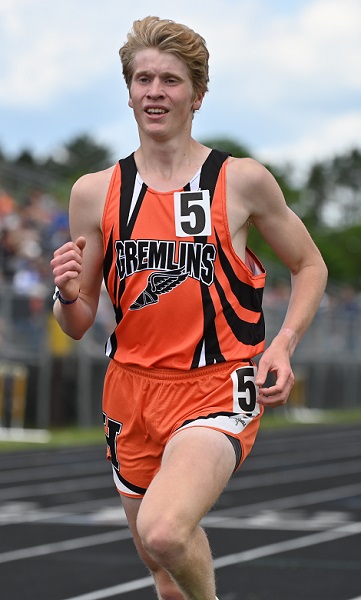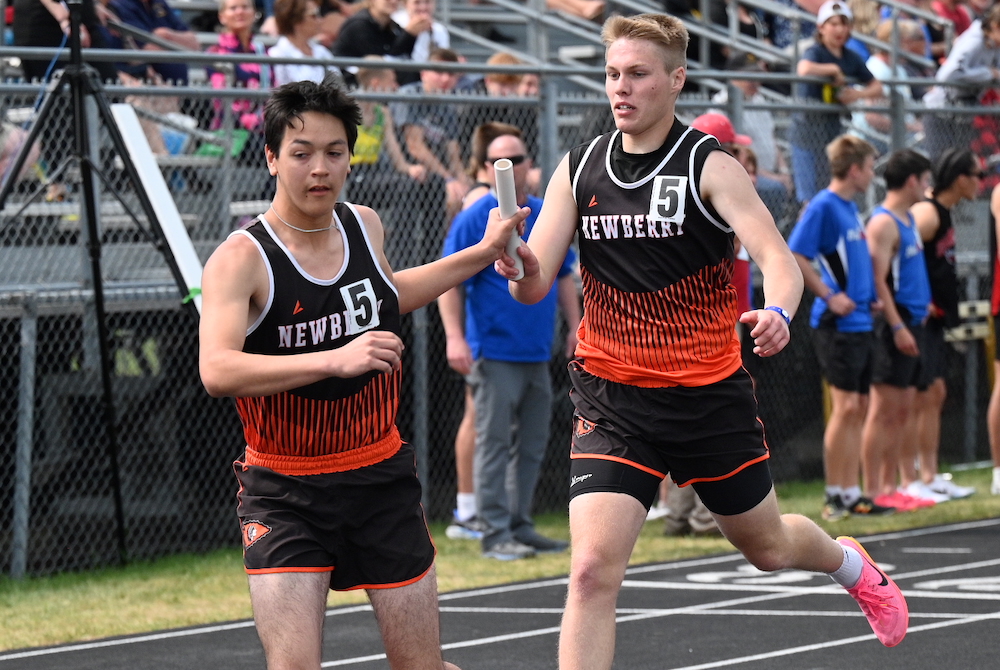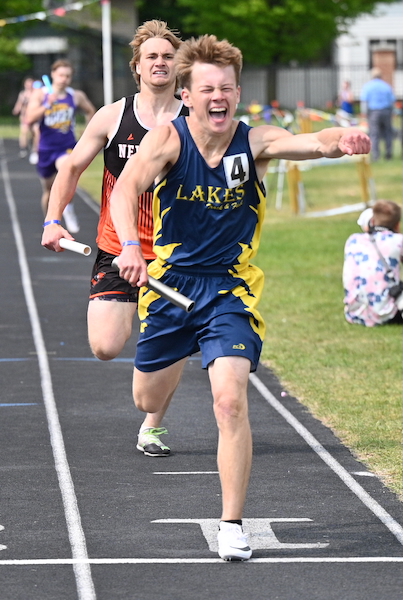
Copper Country Distance Stars Cap Senior Seasons with Fast Finals Finishes
By
John Vrancic
Special for MHSAA.com
June 13, 2022
CALUMET — It was quite a workout for Dollar Bay’s Nik Thomas and Houghton’s Eric Weiss whenever they met in area track meets this season.
 A prime example was on display during the Houghton County Invitational on May 13 at Houghton when both seniors were clocked under 10 minutes in the 3,200-meter run.
A prime example was on display during the Houghton County Invitational on May 13 at Houghton when both seniors were clocked under 10 minutes in the 3,200-meter run.
Thomas won in a school-record 9:54.91, and Weiss was runner-up at 9:56.47.
Thomas also set a school record at that time in the 1,600 while winning in 4:26.58. Weiss was clocked at a personal-best 4:30.71.
“Breaking 10 minutes in the 3,200 was a huge accomplishment.” Thomas said after winning four races in the Division 3 Regional at Lake Linden on May 18. “I was really proud of that. Kolson Kytta (last year’s UPD3 1,600 and 3,200 champ and now assistant track coach at Chassell) called out my splits at Houghton, and I really appreciate that. What’s neat is every time I ran a PR, I set a school record.”
Thomas then established Upper Peninsula D3 Finals records June 4 in the 1,600 (4:25.91) – which topped his previous school record – and 3,200 (10:05.59).
He also won the 800 (2:01.27) at the U.P. Finals in Kingsford.
Weiss was Division 1 runner-up in the 800 (2:03.18) and 3,200 (10:07.12) and third in the 1,600 (4:37.2) at the Finals.
Thomas also set the school record in the 800 (1:59.92) in the Copper Country Invitational in Houghton on May 16 and added three victories in the Copper Mountain Conference meet at Wakefield on May 24.
“Nik is crazy fast,” said Weiss, who won the 3,200 in a personal-best 9:49 at the Ontonagon Invitational May 6. “I was very happy with running a 4:30 in the Houghton County Invitational. That was also a great race when I got my PR at Ontonagon. I definitely felt good that day.”
 Also in the mix was Ewen-Trout Creek senior Jonah Nordine, who was the UPD3 Finals runner-up in the 800 (2:06.39), 1,600 (4:40.3) and 3,200 (10:26.51).
Also in the mix was Ewen-Trout Creek senior Jonah Nordine, who was the UPD3 Finals runner-up in the 800 (2:06.39), 1,600 (4:40.3) and 3,200 (10:26.51).
Weiss, who took the Western Peninsula Athletic Conference title in the 1,600 (4:37.44) and 3,200 (10:21.03) on May 31 at Calumet, became interested in distance running as a freshman.
“I went out for cross country and started enjoying it,” said Weiss, who plans to continue his running career this fall at North Dakota State University in Grand Forks. “I’ve also done cross country skiing and a little bit of running in the winter.”
Thomas, who temporarily battled paralysis during his sophomore year, says he was proud to represent his school.
“I got into such a zone,” said Thomas, who also set two meet records in the Houghton County and Copper Country Invitationals. “There were times when I lost my vision. While I was paralyzed I never thought this would be possible, but everybody was so supportive.
“Going under two minutes in the 800 was unbelievable. We’re such a small school. Everybody knows everybody. I don’t think you’ll find this kind of experience anywhere else.”
 John Vrancic has covered high school sports in the Upper Peninsula since joining the Escanaba Daily Press staff in 1985. He is known most prominently across the peninsula for his extensive coverage of cross country and track & field that frequently appears in newspapers from the Wisconsin border to Lake Huron. He received the James Trethewey Award for Distinguished Service in 2015 from the Upper Peninsula Sportswriters and Sportscasters Association.
John Vrancic has covered high school sports in the Upper Peninsula since joining the Escanaba Daily Press staff in 1985. He is known most prominently across the peninsula for his extensive coverage of cross country and track & field that frequently appears in newspapers from the Wisconsin border to Lake Huron. He received the James Trethewey Award for Distinguished Service in 2015 from the Upper Peninsula Sportswriters and Sportscasters Association.
PHOTOS (Top) Dollar Bay’s Nik Thomas leads the pack near the end of the first lap of the UPD3 800 race at the June 4 Finals at Kingsford. (Middle) Houghton's Eric Weiss runs a straightaway during the UPD1 3,200 championship race. (Photos by Cara Kamps/Run Michigan.)

Newberry Clinches 1st Track & Field Finals Repeat in 2 Decades
By
John Vrancic
Special for MHSAA.com
June 1, 2025
KINGSFORD — Nearly two decades ago, the Newberry boys became Upper Peninsula Division 2 track & field champs in back-to-back years.
They accomplished the same here Saturday, retaining their Division 3 title with 84 points, Runner-up Lake Linden-Hubbell scored 73, with Bessemer a surprising third at 46.
“We kind of did what we had all season,” Newberry coach Drew Schultz said. “We were kind of top heavy. We were lacking depth a little, but I knew if the guys did what they did all season, I liked our chances. This is the first time we won back-to-back years since I was in high school (2005-06). This is fun, bringing four championship trophies back to the eastern U.P. Pickford’s kids did a nice job (sweeping titles) in D-2.”
Newberry started this day on a positive note, winning the 3,200-meter relay in a season-best 8:42.67.
Senior Connor Carlson, who anchored that relay, also placed fourth in the 200 (24.31) and 400 (54.07).
“It feels good to win,” he said moments after finishing the relay. “I love winning. Garrett (Lewicki) ran a great first leg. Everyone was rolling. This sets the tone pretty good.”
Lewicki also anchored the 1,600 relay which placed second (3:42.47), and took third in the open 800 (2:09.83).
Newberry senior Matt Rahilly won long jump at 20-4½ and high jump (6-0), placed second in the 100 (11.51) and third in the 200 (24.24). Classmate Ethan Pavey added a first in shot put (43-6½).
Senior Dakota Taylor, who will run cross country at North Central Michigan College in Petoskey this fall, provided Engadine with a solid showing. He took second in the 3,200 in a personal-best 10:20.96 and third in the 1,600 (4:51.61), and helped the Eagles place fourth in the 3,200 relay (9:08.59).
Brimley swept the sprint relays, taking the 400 (46.78) and 800 (1:36.75), and senior Adrian Kunowski took pole vault (11-1).
“I’d say our handoffs went well,” Brimley sophomore Gus Vonseggem said. “We didn’t qualify last year. Cooper (Jones) and Trey (Lynn) joining the team made a difference. We really wanted to break the school record. We still need to make our handoffs a little better. It takes a lot of offseason work. Overall, we’re happy with the team’s performance.”
Chassell senior and Michigan Tech recruit Kalvin Kytta was a triple-winner, taking the 800 at 2:03.71, 1,600 in a personal-best 4:28.58 and 3,200 (10:11.42).
“I’m very happy with my season,” he said. “I was going for the record in the 3,200, but just couldn’t quite get that today. The PR (personal record) in the mile was kind of a reflection win.
“Glory to God for sure. He gives me the strength to do all this. I’m getting to know the guys a little at Tech. I’m thankful to God for providing me with this opportunity.”
Lake Linden-Hubbell sophomore Lukas Axford captured the 300 hurdles (42.46) and anchored the winning 1,600 relay (3:41.89). Watersmeet senior Thomas Caron was a double winner, taking the 200 (23.91) and 400 (52.36) and adding a fourth in the 100 (11.75).
Bessemer senior Bryce Martin won the 100 (11.44), and sophomore Jayden Verrett was runner-up in the 200 (23.92), third in the 100 (11.52) and anchored two second-place sprint relays.
PHOTOS (Top) Newberry's Garrett Lewicki hands off the baton to Danny Mikus during the 1,600 relay Saturday. (Middle) Lake Linden-Hubbell's Lukas Axford celebrates his team's win in that race. (Click for more from Cara Kamps/RunMichigan.com.)

